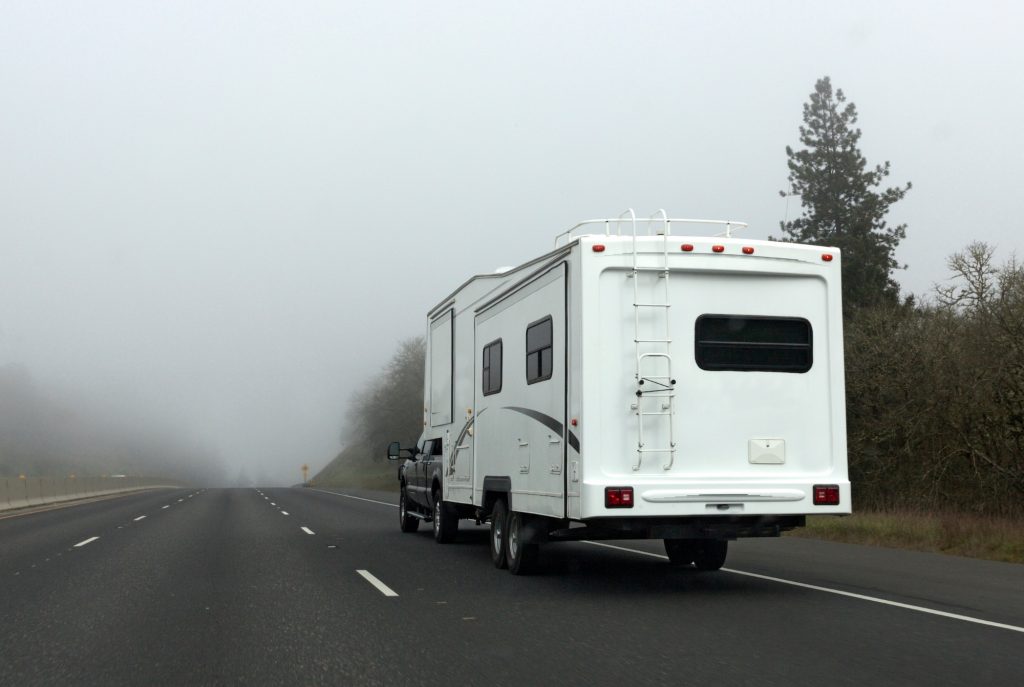
As an RV owner, being aware of the weather should be one of your top priorities.
To be prepared for different weather conditions, always have an emergency kit in your RV that includes things like clothes, medical supplies, a flashlight, road flares, batteries, a cell phone charger, a source of heat, and non-perishable food.
You can’t predict the weather, but you can be prepared for it. Here’s how to handle different weather conditions when driving your RV.
SNOW AND ICE
Just like you would when driving your car or truck, slow down when driving your RV during snowy weather. Just like with fog, avoid using your brights since that would cause the snow to reflect and make it harder for you to see. Instead, use your low beams.
When there’s snow or ice on the road, don’t break quickly or turn quickly — either could cause you to lose control. Trust your instincts. If you aren’t comfortable, find a rest stop. It’s even more difficult to drive in snowy conditions at night, so avoid doing so when at all possible.
RAIN
During periods of heavy rain with the potential for flooding, move to higher ground. Don’t drive through standing water. Even if you think you can tell how much water there is, looks can be deceiving. Don’t use your high-beam headlights. Always keep your RV fueled — you never know when you may have to relocate due to weather.
STORMS
As an RV owner, take the time to learn about different weather conditions and terms like thunderstorm warning and thunderstorm watch. Check the weather forecast often.
If your RV has an outer layer of metal, you’re safe from lightning. If it were to strike, it would deflect. When driving in a storm, slow down. While this tip may sound simple, we all get caught up in our own predetermined plans at times. Your safety is always more important than your estimated arrival time. Being safe should be your top priority, and that may mean you need to stop driving entirely.
WIND
Travel trailers can sway in heavy winds, which may cause you to overcorrect, which is a very dangerous situation to be in. Driving in high winds can be dangerous and tiring due to the difficulty, so stop driving if you feel unsafe or lose control of your RV.
FOG
When it’s foggy outside, slow down and turn on your headlights. Many RVs are white, and if yours is too, it will be more difficult for other drivers to see you. To make sure you’re visible, switch on your emergency flashers if the fog is very thick.
Just be sure to avoid using high-beam headlights. Fog is made up of small water droplets that reflect light, which can make visibility worse.
TORNADOS AND OTHER EXTREME WEATHER
If a storm turns into a tornado, don’t try to outrun it. Seek shelter, but avoid parking under an overpass. This actually puts you at greater risk. If you’re on a campsite, move your rigs away from trees or branches. Seek underground shelter. If you’re driving when you spot a tornado, pull over, get out of your RV, and find the lowest point on the ground, like a ditch, to lay down in. Do not keep driving.
HEAT
Your RV likely has dashboard air conditioning, but this won’t keep your entire RV cool in the case of extreme heat. Consider cracking some windows and running vent fans to keep air circulating. If you feel exhausted from the heat, take a break from driving. Try to avoid driving during the warmest time of the day.
When you park, try to park in the shade and pull down your window shades to help keep your RV cool. Be sure to have plenty of water with you. Drink lots of water, avoid caffeine, and wear light, loose clothing.
Now that you’re ready to confidently get on the road, get your RV from RV Dynasty. We carry new and pre-owned RVs from the brands you know and love. Visit us at 10001 S US Highway 31 in Bunker Hill, Indiana — about an hour north of Indianapolis — to view our vast inventory or contact us today for more information.
